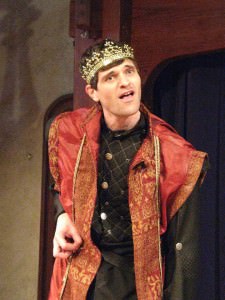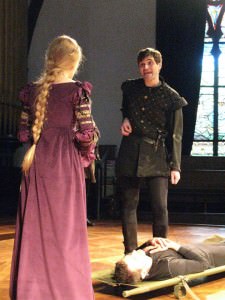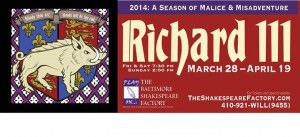‘Tis indeed the winter of our discontent with the never ending snow. And what better way to dispel the forces of winter than for the The Baltimore Shakespeare Factory to kick off their 2014 season, appropriately entitled “Malice and Misadventure” with the bloody dog of tragedies, Richard III. Directed by Tom Delise, this production is giving the audience an authentic Shakespearean experience. Focusing on the traditional perimeters of how the Bard’s works were originally presented, the BSF employs the use of universal lighting, minimalist set structure and design, as well as incorporating music of the time before the show, during the intermission and to close the production. The company creates an atmosphere for Shakespeare’s ideas and emotions to flourish without the modern trappings of new themes, re-invented approaches, or other devices of creative license. Going back to the basics, a bare-bones Shakespearean concept, BSF is able to present this tragedy with integrity in the character work and critical plot development.

Without intense scenery or thematic elements the production relies solely on the actors to create the atmosphere, and on the work of Costume Designer April Forrer to inspire the audience to Shakespearean England. The use of her medieval inspired costumes gives each character a distinguished and unique look. Black and darker hues of red and purple are reserved for the ilk of Richard, his supporters and followers, while the bloody tyrant himself dons a quilted doublet of black and shimmering dots of silver. It is fascinating to note the shiny white boar emblems; their glossy gleam radiating in stark contrast against the dark threads to identify noblemen’s allegiance with Richard. The symbolism therein speaks volumes not only of the bright divinity of given right to the throne, but also of Richard’s tiny conscience attempting to shine forth from the blackness of his soul. Forrer’s work with the dresses, particularly the regal purple dress use for Ann, creates a sense of nobility in the females of the production.
The incorporation of music into the work of Shakespeare is a treasured favorite among theatergoers; and those in favor of the trend will thoroughly enjoy what this production has to offer. It’s the music at intermission that really grabs the attention: Queen Margaret singing a heinous rendition of “Out of Me Onto You” in the full vibrancy of her imposing character and Richard then giving an acoustic rendition of “London Calling.” There is something deeply satisfying and ironically symbolic about both of these performances. But it’s Director Tom Delise’s choice for the closing song that really cements the approval of modern music in this production. To keep from spoiling this truly fitting and humorously ironic moment, the name of the song will not be revealed, one must simply attend the production to hear it.
While the fighting in this production is minimal and reserved until the final bloody battle there is something to be said for having it be clean and concise. Fight Choreographer Tegan Williams crafts very basic swordplay that lingers momentarily upon the stage. A more intense and tighter fight scene almost feels necessary as the depths of depravity Richard reached to attain the throne and the vengeful urge to thwart him clash head to head. Richard’s ultimate undoing also feels lackluster and could be delivered on a grander scale, though what the scene lacks in action, the Earl of Richmond (played by Barbara Madison Hauck) more than makes up for with the bellowed proclamation of his death.
Director Tom Delise uses just 15 actors to play over 50 characters in this bloody tragedy and his ability to keep each one as a unique portrayal is beyond impressive. While the adjustment in costume might be as simple as changing an over-vest or tunic, the mannerisms and vocal patterns, and often full-bodied physicality, are completely different. Delise also does an exceptional job of keeping the play moving. Scenes, while not overlapping, do tumble one atop the next with just a breath’s pause between one group of actors leaving the stage and another group entering. This keeps the chaos of the play moving like a dervish, keeping the audience engaged and not allowing them time to get lost in the long and convoluted plot that this tale contains.
Delise’s blocking for the ghostly apparition scene is one of swift genius; allowing for a parade of spectral figures to flow onto the stage, one rapidly after another. Spitting venomous curses at Richard, a simple pivot on their feet has them whispering vengeful praises of great strength and Mercy to Richmond; the duality and surging energy of this scene is a furious build-up to the play’s conclusion.
Delivering in the upward of half a dozen characters, Lily Kerrigan exemplifies herself as a versatile performer. Playing a series of men and women, Kerrigan hones in on near-perfect performances for each delivery. Her weakest character portrayal is Lady Ann as the character starts at a heightened level of anger and never plays it higher in the biting and ruthless exchange with Richard. Kerrigan’s anger is limited in this scene and fails to drive the dialogue between the two characters. Her portrayal of young Richard, Duke of York is brilliant; a petulant and ornery youth with stinging quips upon the lips poised and punctuated to mock both her character’s brother and her bloody tyrant uncle. Even as Murderer #2, Kerrigan shows a flexibility in her delivery; a savage yet frightened fellow with an edge of uncertainty hovering on the periphery of every line delivered.
Tackling the majestic role of Queen Elizabeth is Kelly Dowling; her stage presence a commanding one, even when she stalks about in mourning. Dowling possesses a mastery of vocal manipulation, raising her voice to a great swelling crescendo that thunders out of her with a tsunami-like force when confronting Richard in Act II. Juxtaposing this against the more effeminate weeping of her sorrow creates a dynamic portrayal of this Monarch.
Rounding out the women of note in this production is Barbara Madison Hauck, recognized most for her revolting and heinous delivery of unbridled revenge from the lips of Queen Margaret. Dripping with disdain and loathing, Hauck adapts a ferocious voice for the character that stirs even the hearts of lions to quake when she launches into her pox of curses. It’s Hauck’s keen understanding of Shakespearean phrasing and meter that allow her delivery to intensify tenfold; the vicious bark of a maddened cur raving at full blast with a healthy dose of scorned fury blended with lunacy. Hauck takes the performance one step further and adapts a crippling physicality, to which she maintains immaculate consistency, furthering the putrid depths of this rank character.
As only one of two players not adapting more than one role, Ian Blackwell Rogers takes the character of The Duke of Buckingham to new heights. Pushing the comedic boundaries of the character in the interactive audience scene, Rogers plays up the simplistic humor Shakespeare has subtly crafted into the text. His over the top mannerisms and vocal play in this scene alone bring a shining, albeit dark, sense of levity to the production as a whole. The somber mood that washes over his character’s visage near the conclusion of the play showcases his versatility as a performer.

Down with the bloody tyrant! Taking the most villainous knave in the Shakespearean cannon and creating him with the complexity and depth that Chris Cotterman does is a performance worthy of an award. Despite the wavering inconsistency of the crippling limp in his gait, Cotterman delivers a stellar performance of this venomous viper. His true serpentine nature is reflected in the way he delivers every word up until the moment his vulnerable humanity cracks through the blood-soaked tyrannical tirades. Cotterman finds the epitome of balance with this character, keeping lunacy hovering just out of his mind’s eye while charging each declaration with a full surge of unrestrained emotions. With a voraciously insatiable lust for power; Cotterman delivers the bloody king to his throne in due course with a stunning approach to his villainous side.
With so many performers giving exceptional performances, the best overall recommendation that can be made is to simply go see them all; for unlike Shakespeare, this columnist hath not the limitless bounds of space for words in print. The production rings true to authentic and original Shakespeare as the Bard intended it. Come see The Baltimore Shakespeare Factory’s production; lest of course, you fear the Boar?
Running Time: Approximately 2 hours and 45 minutes, with no intermission.





